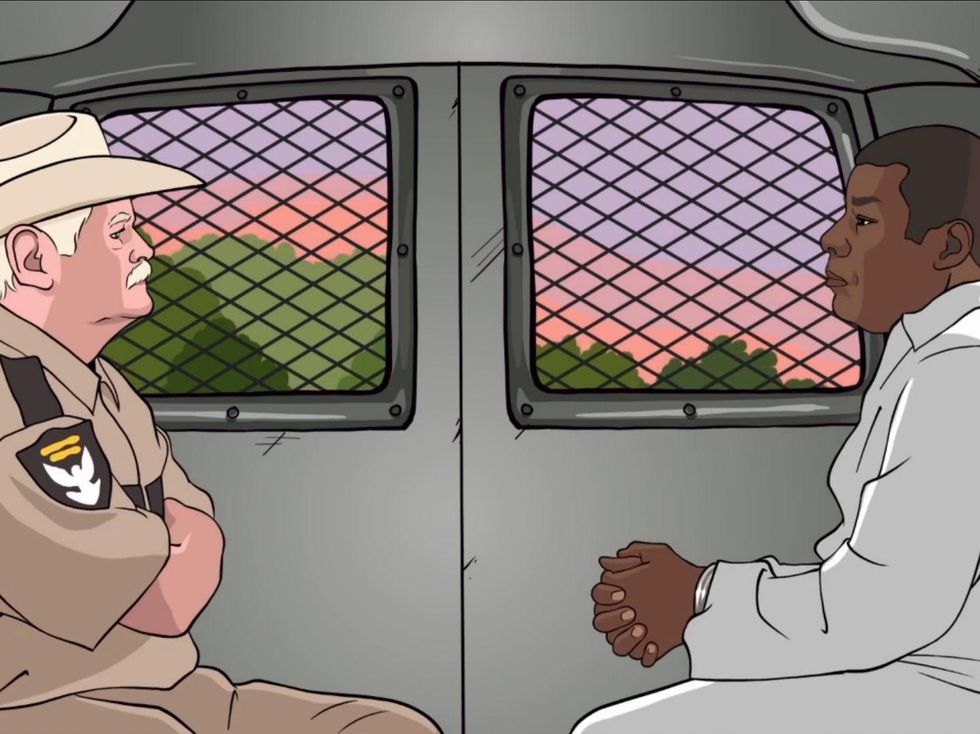Drama Through Animation
Texas-made animated short tackles human side of death penalty debate
When most people think about animated short films, their minds usually go to pieces from Disney and other traditional animation studios.
But the form of filmmaking can also be a way to talk about more serious subjects, as in The Last 40 Miles, playing as part of the Dallas International Film Festival Animated Shorts Competition. It shows April 7 and 8 at Angelika Film Center Dallas.
The film is the brainchild of writer/director Alex Hannaford, an Austin-based journalist who has covered the death penalty for more than a decade. Based on a true story, it depicts a prisoner named Ray being transported from death row in Livingston, Texas, to the prison in Huntsville, where executions are carried out.
"We just wanted to make people think a bit about this ultimate form of justice and how it's carried out," says writer/director Alex Hannaford.
There are several noteworthy aspects about the film. From a purely visual perspective, it features three distinct animation styles meant to represent different parts of the story. Hannaford says those choices, and the idea of using animation in the first place, came from animators Jeff Roth and Lucas Dimick.
"They wanted to convey the difference between present, past and Ray's 'imagination' in the story," Hannaford says. "Everything happening in the present time is told via rotoscoping, flashbacks are told in freehand animation and Ray's childlike imagination is conveyed using white on black sketches."
Fans of the Richard Linklater films Waking Life and A Scanner Darkly will recognize the style of the rotoscoping scenes, a process where actors are traced frame by frame by animators. Jennifer Deutrom of Flat Black Films, the same company responsible for those films, animated those scenes.
The film mostly stays away from whether or not the death penalty is justified, although the lengths it goes toward humanizing Ray does seem to indicate a certain empathy with condemned prisoners. Hannaford says he wasn't really trying for one or the other.
"I don't mind admitting I'm anti-death penalty, but I don't think The Last 40 Miles is an anti-death penalty film necessarily," Hannaford says. "I think it's too easy to think of every inmate on death row as a monster; the truth is much more complicated.
"With The Last 40 Miles, I just wanted to tell the story of one man. He was bullied at school. He is developmentally disabled. He has a family that loves him. And this is based on a true story, so I'm not really editorializing. We just wanted to make people think a bit about this ultimate form of justice and how it's carried out."
A big part of the story in the film is the drive itself, one whose beauty stands in sharp juxtaposition with the ugly fate that awaits those who take it.
"The road is a 40-mile stretch, and it's incredibly beautiful," Hannaford says. "It goes past a lot of countryside, pine trees and forest, and a huge lake, Lake Livingston, and this is the last thing these men ever see."
However each individual viewer interprets the film, Hannaford just hopes that the DIFF screenings are stepping stones toward bigger things for the film and his new filmmaking company.
"Our plan is to enter it into more film festivals this year, and possibly in early 2015, and then decide what to do with it after that," Hannaford says. "We formed a company called Onalaska Films to make The Last 40 Miles, and we would like to make a documentary next.
"I'd love people who maybe haven't really given the death penalty much thought to watch it. If it gets people talking, then we'll have done our job."














